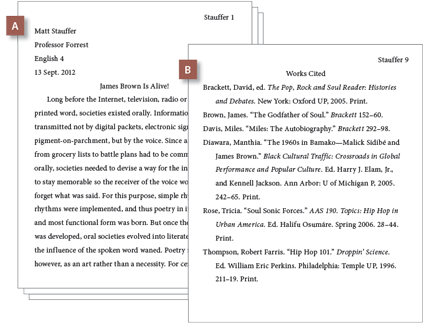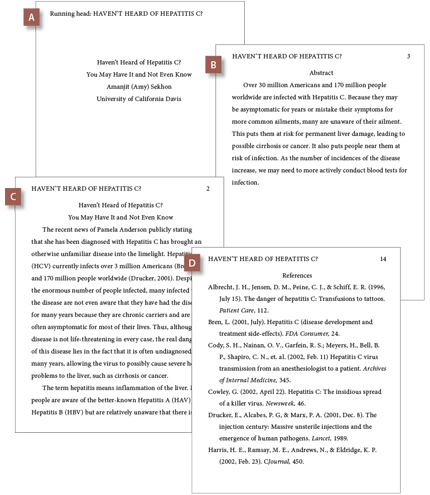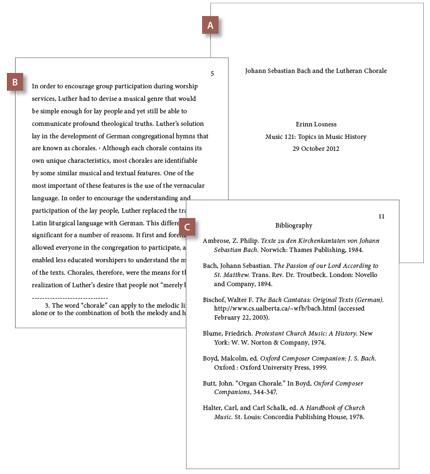396
Using a Citation Style
Different fields of study format documents and cite sources in different ways, as shown on the next three pages. See pages 397–402 for details about formatting student papers.
MLA (Modern Language Association) Citation
MLA style is typically used for the humanities—languages, literature, philosophy, and so on—in which a source’s age does not dictate its value. Within an essay, MLA identifies sources by author and page number. Full publication details are given at the essay’s end in a list of works cited, alphabetized by author.
A typical citation ends with author and page in parentheses. | Through history’s lens, any contradiction between free will and predestination evaporates. We see people make decisions freely even as we see the forces influencing them (Tolstoy 1007-1009). |
A citation can open with author’s name and close with page numbers, for clarity. | Tolstoy argues that history as a science reconciles any seeming contradiction between free will and predestination. In its moment, every decision seems arbitrary, but the more distant our view, the more forces we perceive influencing that choice (1007-1009). |
Matching works- cited entry (book) | Tolstoy, Leo. War and Peace. New York: Random House, 1955. Print. |
Common MLA Works-Cited Entries
List author by last name, then first. (Use normal order for any additional authors: “Smith, Jon, and Jo Jones.”) “Medium of publication” may be “Print,” “Web,” “CD,” and so on. “Pages” means the page range of the article. For Web resources, use “n.p.” if no publisher can be identified, “n.d.” for no date of creation.
| Book: | Author(s). Book Title. City of publication: Publisher, year of publication. Medium of publication. |
| Magazine article: | Author(s). “Article Title.” Periodical Title Day Month Year: pages. Medium of publication. |
| Article in a scholarly journal: | Author(s). “Article Title.” Journal Title Volume.Issue (Year): pages. Medium of publication. |
| Web site: | Editor, author, or compiler name. Site Name. Site sponsor or publisher, date of creation. Medium of publication. Date of access. |
| Web page: | Author(s). “Page name.” Site Name. Site sponsor or publisher, date of creation. Medium of publication. Date of access. |
For more examples, see thoughtfullearning.com/h396.
397
MLA Student-Paper Format
A student paper in MLA format needs no title page. All pages have a one-inch margin on all sides, with a running head in the upper right corner listing the writer’s last name and the page number. All text is double-spaced (except captions for graphics), and works-cited entries are formatted with a hanging indentation. (You can find more MLA details and view the full report at thoughtfullearning.com/h397.)
MLA Format
A
■ Running head 1/2 inch from top
■ 1-inch margins on all sides
■ First page with identifying details
■ Title centered
■ All text double-spaced
B
■ Abbreviated entries for sources from the same anthology
■ Hanging indentation used
■ Works cited alphabetized

Journalistic Citation
Newspapers, popular magazines, and many books document their sources by working identifying information into the text itself, without a bibliography or list of references.
The source (a person) is identified within the text of the first sentence. | Adela Encinas, CEO of MagroCorp, argues that Congress must pass new tax laws to better sync with the global marketplace. “It makes no sense,” she says, “to punish local businesses with taxes that local offices of international businesses are able to sidestep.” |
398
APA (American Psychological Association) Citation
APA style is most often used in the behavior and social sciences—psychology, anthropology, ecology, sociology, and so on—where timeliness of information is important. In an essay, APA identifies a source by author and date, matched to an alphabetized list of references.
A source’s author and date are shown in parentheses. | Though it is difficult to show a statistical correlation between pollution and marine disease, pollutants are clearly stressors, and stressors make fish vulnerable to infection (Sindermann, 1996). |
Matching reference entry (book) | Sindermann, C. J. (1996). Ocean pollution: Effects on living resources and humans. Boca Raton, FL: CRC Press. |
Common APA Reference Entries
List all authors by last name, then first initial (and middle, if given). Separate authors with commas, and place an ampersand (&) before the last. Place the year of publication in parentheses, followed by a period. In book and article titles, capitalize only the first word (and any proper nouns). For location of publisher, list city and state abbreviation (or country for foreign publishers). For online articles, follow the print format with a “doi” (digital object identifier) if available or a “Retrieved from” note.
Book | Author, A. A., & Author, B. B. (Year of publication). Title of work: Capital letter also for subtitle. Location: Publisher. |
Article in a journal paginated by issue | Author, A. A. (Year). Title of article. Title of Periodical, volume number(issue number), pages. |
Article in a journal paginated by volume | Author, A. A. (Year). Title of article. Title of Periodical, volume number, pages. |
Magazine article | Author, A. A. (Year, month day). Title of article. Title of Periodical, volume number, pages. |
Online article with doi | Author, A. A. (Year). Title of article. Title of Periodical, volume number(issue number), pages. doi:0000000/000000000000 |
Online article, “Retrieved from” | Author, A. A. (Year). Title of article. Title of Periodical, volume number(issue number), pages. Retrieved from http://www.example.edu/path/page |
Web page | Author, A. A. (Date of publication). Title of document. Retrieved from http://Web address |
For more examples, see thoughtfullearning.com/h398.
399
APA Student-Paper Format
A student paper in APA format normally requires a title page and an abstract. All pages have a one-inch margin on all sides, with a shortened title as a running head in the upper left corner and a page number in the upper right. (On page 1—the title page—the running head is preceded by the phrase “Running head:”) All text is double-spaced (as are any captions included with figures, unless your instructor allows single spacing), and reference entries are formatted with a hanging indentation. See the example pages that follow.
APA Format
A
■ 1-inch margins on all sides
■ Title, author, and school name centered, roughly one-third down the page
B
■ Running head flush left, 1/4 inch from page top
■ Page numbers flush right, 1/4 inch from page top
■ “Abstract” title centered
C
■ Paper title centered on first page
D
■ “References” heading centered
■ Entries alphabetized
■ Formatted with hanging indentation

400
CMS (Chicago Manual of Style) Citation
CMS format can use either a numbered notation—common in the humanities—or an author-date notation—common in the sciences.
Author-Date Notation
Full publication details are given in a reference list.
In-text citation, open with author’s name and end with the date in parentheses | Henig explains that while the dangerous side effects of ketamine make it too dangerous for antidepressant use, the motion-sickness drug scopolamine shows promise as a fast-acting solution (2012). |
In-text citation, end with both author and date in parentheses. | The dangerous side effects of ketamine make it too dangerous for antidepressant use, but the motion-sickness drug scopolamine shows promise as a fast-acting solution (Henig 2012). |
Matching reference- list entry | Henig, Robin Marantz. 2012. “Lifting the Black Cloud.” Scientific American 306 (3): 66. |
Common Author-Date Entries
CMS author-date documentation is similar to the style used for MLA bibliography entries. The significant differences are that (1) the year of publication is moved forward to just after the author’s name, and (2) the page of entries is titled “References.”
Book | Author’s last name, first name. Publication year. Book Title. Publication city: Publisher. |
Periodical | Author’s last name, first name. Publication year. “Article Title.” Periodical Title volume (issue no., month, or season): page number(s). |
Online article with doi | Author’s last name, first name. Publication year. “Article Title.” Periodical Title volume (issue no., month, or season): page number(s). doi:0000000/000000000000. |
Online article with URL | Author’s last name, first name. Publication year. “Article Title.” Periodical Title volume (issue no., month, or season): page number(s). http://www.example.edu/path/page. |
For more examples, see thoughtfullearning.com/h400.
401
Numbered Notation
Superscript numbers point to notes. Full publication details are given either in those notes or in a separate alphabetized bibliography.
In-text citations | Suzanne M. Bianchi notes that “the family system is more turbulent in the United States than elsewhere.”19 She says single parents now head a quarter of U.S. households with children.20 |
Matching footnote or endnote | 19. Bianchi bases this statement upon studies by Andrew Cherlin. See note 8. |
Footnote or endnote with publication details | 20. This is true across the spectrum of social classes. Suzanne M. Bianchi, “Changing Families, Changing Workplaces,” Future of Children 21, no. 2 (Fall 2011): 15-36. |
Bibliography entry (if not included in notes) | Bianchi, Suzanne M. “Changing Families, Changing Workplaces.” Future of Children 21, no. 2 (Fall 2011): 15-36. |
Common Numbered-Citation Entries
If you supply full publication details in your footnotes or endnotes, you will not need a bibliography. But if you must prepare a bibliography, notice that the treatment of the author’s name and the punctuation of the publication details varies between a note and a bibliographic entry. Remember, too, to include specific page numbers in your notes for information you’ve quoted or paraphrased from a source.
Book in notes | Note number. Author’s first and last name, Book Title (Publication city: Publisher, publication year), page number(s). |
Book in bibliography | Author’s last name, first name. Book Title. Publication city: Publisher, publication year. |
Periodical article in notes | Note number. Author’s first and last name, “Article Title,” Periodical Title volume, issue number (year): page number(s). |
Periodical article in bibliography | Author’s last name, first name. “Article Title.” Periodical Title volume, issue number (year): page number(s). |
Online document in notes | Note number. Author’s first and last name, “Document Title,” Site Title, publication information [e.g., volume, posting date], Internet address (access date). |
Online document in bibliography | Author’s last name, first name. “Document Title.” Site Title, publication information [e.g., volume, posting date]. Internet address (access date). |
402
CMS Paper Format
In CMS format, either prepare a title page or include the title on the first page of text. (Follow your instructor’s preference.) Leave a 1-inch to 1½-inch margin on all sides of a page. Place page numbers in the upper right corner, beginning with the first page of text, and double-space the body text. Single-space each note, bibliography entry, or reference entry, and double-space between them. Use hanging indentation for both bibliographies and reference lists. See the example pages below. (You can find more CMS details and view the full report in both numbered-note and author-date formats at thoughtfullearning.com/h402.)
CMS Format
A
■ 1-inch to 1½-inch margins on all sides
■ Title centered one-third down the page
■ Writer, course, and date several lines below title
B
■ Page numbers flush right, in upper margin, starting on first page of text
■ Footnote identified by superscripted number
■ Footnote indented, single-spaced*
*Double-space between multiple notes.
C
■ Individual entries are single-spaced, but double-space between them.




